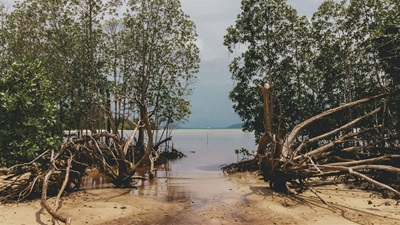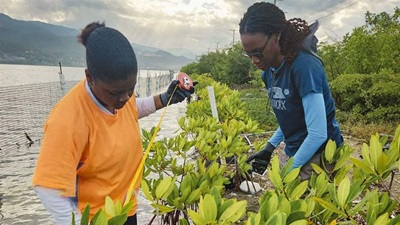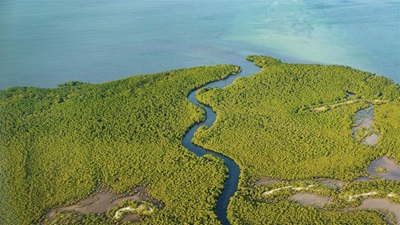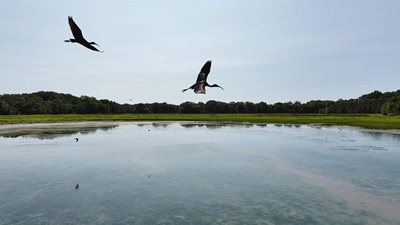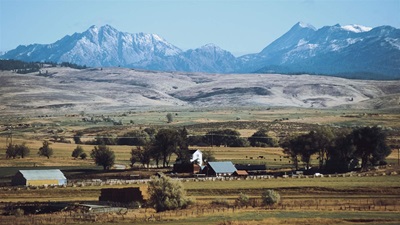Jamaica’s New Climate Commitments Recognize Conservation Value of Coastal Wetlands
Mangroves and seagrass meadows sequester carbon and provide wildlife habitat, benefiting people and nature

Jamaica is home to a variety of thriving natural habitats and now, for the first time, has committed to ambitious, measurable targets for the conservation and restoration of its coastal wetlands—namely mangroves and seagrasses. The government formalized these commitments Sept. 22 as part of its updated nationally determined contribution (NDC 3.0) to the United Nations Framework Convention on Climate Change (UNFCCC); countries that are party to the landmark 2015 Paris Agreement must update their NDCs every five years.
For Jamaica, the new NDC’s inclusion of coastal wetlands—known as “blue carbon” ecosystems because they are marine areas with significant carbon storage capacity—marks a significant milestone in the country’s climate policy. Aside from their climate benefits, coastal wetlands also provide nursery and feeding areas for a wide range of marine life, which in turn helps to support fisheries and tourism economies.
The commitments grew from more than two years of collaboration between Pew and its in-country partners, the Government of Jamaica, The Nature Conservancy (TNC), and the Centre of Marine Sciences at the University of the West Indies (UWI) at Mona. These partners provided technical support, conducted field-based mapping and carbon assessments, and engaged closely with the government’s Climate Change Division and other stakeholders to ensure that coastal wetlands were recognized as critical nature-based solutions in the country’s climate strategy.
As Water, Environment, and Climate Change Minister Matthew Samuda stated: “Blue carbon ecosystems, specifically mangroves and seagrass, are critical to Jamaica’s climate priorities and help support livelihoods such as fishing and tourism. Integrating blue carbon ecosystems into national climate strategies provides an opportunity for Jamaica to address both mitigation and adaptation priorities.”
Ambitious commitments to mangroves and seagrass
Jamaica’s updated NDC includes the following targets:
- Complete a national seagrass map and carbon stock assessment by 2025.
- Include mangroves in Jamaica’s National Greenhouse Gas Inventory by 2030.
- Restore at least 2,200 hectares (5,436 acres) of mangroves by 2030, with an additional 1,000 hectares (2,471 acres) by 2035.
- Protect approximately 67% of the island’s mangrove forests by 2033.
- Protect at least 4,400 hectares (10,873 acres) of public mangroves by 2035.
- Conserve 100% of seagrass ecosystems within legally declared protected areas by 2035.
- Develop and implement a no-net-loss policy for forests and coastal wetlands by 2035.
These targets represent a significant change from Jamaica’s previous NDC, which contained no specific commitments for coastal wetlands.
Dr. Kristinia Doughorty, senior policy adviser at TNC in Jamaica, stated: “TNC collaborated with various stakeholders to develop coastal wetland targets for Jamaica’s NDC 3.0. This inclusive process emphasized broad-based engagement and cross-sector collaboration in setting ambitious, science-driven climate goals. TNC is committed to working with partners to implement these targets and advance nature-based solutions for a resilient and sustainable future.”
Science to policy: A collaborative model
The new targets were informed by a robust body of scientific work supported by Pew and its partners. This included:
- Completion of the first comprehensive mapping of Jamaica’s nearshore seagrass beds as well as a carbon assessment of its nearshore seagrass.
- Provision of updated mangrove maps and carbon stock assessments.
- Technical guidance on integrating blue carbon habitats into national climate frameworks.
These efforts were coordinated through regular engagement with the Climate Change Division, Forestry Department, Climate Change Advisory Board, and other government agencies. Jamaica’s updated NDC also highlights the country’s endorsement of the Mangrove Breakthrough and its participation in the Mangrove Breakthrough NDC Task Force, which Pew co-leads.
Professor Mona Webber, head of the Department of Life Sciences at UWI’s Centre of Marine Sciences, said: “This updated NDC was informed in part by comprehensive spatial mapping and carbon assessment of our mangroves and—for the first time ever—seagrass meadows, which demonstrates Jamaica’s commitment to science-based policy decision-making. UWI was proud to have the opportunity to help support these efforts.”
Looking ahead: From commitments to action
Pew and its partners are committed to supporting Jamaica in turning its new commitments into action. This includes providing technical assistance for monitoring and reporting progress, supporting the development or implementation of relevant national policy, identifying and mobilizing innovative financing for blue carbon ecosystems, and facilitating knowledge exchange with other countries in the Caribbean and beyond.
“Pew is grateful to work in partnership with The Nature Conservancy and the University of the West Indies to support the Government of Jamaica’s efforts to conserve and restore its coastal wetlands,” said Tom Hickey, who directs Pew’s efforts to advance coastal wetlands conservation. “Through research and technical assistance, we will continue to support the country as it works to implement and finance its NDC commitments.”
Jamaica’s NDC 3.0 sets a new standard for the country by integrating blue carbon into national climate policy. It is a testament to what can be achieved through science-based collaboration and sustained policy engagement.
Peter Edwards is an officer with The Pew Charitable Trusts’ conservation science project, and Kim Jensen is a senior manager with Pew’s advancing coastal wetlands conservation project.







